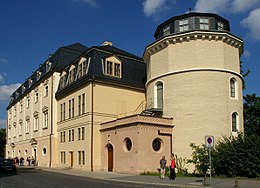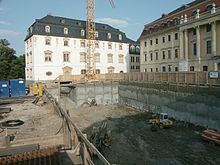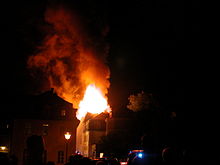
Weimar is a city in the state of Thuringia, Germany. It is located in Central Germany between Erfurt in the west and Jena in the east, approximately 80 km (50 mi) southwest of Leipzig, 170 km (106 mi) north of Nuremberg and 170 km (106 mi) west of Dresden. Together with the neighbouring cities of Erfurt and Jena, it forms the central metropolitan area of Thuringia, with approximately 500,000 inhabitants. The city itself has a population of 65,000. Weimar is well-known because of its large cultural heritage and its importance in German history.

Christoph Martin Wieland was a German poet and writer. He is best-remembered for having written the first Bildungsroman, as well as the epic Oberon, which formed the basis for Carl Maria von Weber's opera of the same name. His thought was representative of the cosmopolitanism of the German Enlightenment, exemplified in his remark: "Only a true cosmopolitan can be a good citizen."
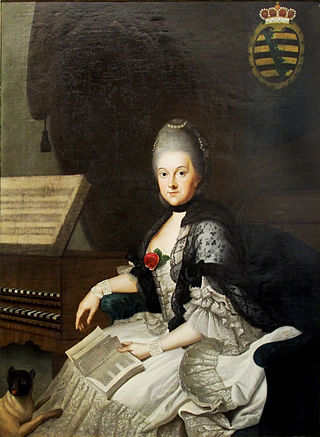
Anna Amalia of Brunswick-Wolfenbüttel, was a German princess and composer. She became the duchess of Saxe-Weimar-Eisenach by marriage, and was also regent of the states of Saxe-Weimar and Saxe-Eisenach from 1758 to 1775. She transformed her court and its surrounding into the most influential cultural center of Germany.
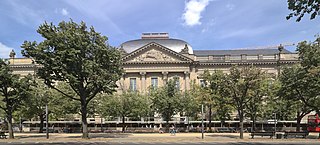
The Berlin State Library is a universal library in Berlin, Germany and a property of the Prussian Cultural Heritage Foundation. Founded in 1661, it is one of the largest libraries in Europe, and one of the most important academic research libraries in the German-speaking world. It collects texts, media and cultural works from all fields in all languages, from all time periods and all countries of the world, which are of interest for academic and research purposes.

Count Heinrich von Bünau was a statesman and historian from the Electorate of Saxony, now part of Germany.

The Saxon State and University Library Dresden, abbreviated SLUB Dresden, is located in Dresden, Germany. It is both the regional library for the German State of Saxony as well as the academic library for the Dresden University of Technology. It was created in 1996 through the merger of the Saxon State Library (SLB) and the University Library Dresden (UB). The seemingly redundant name is to show that the library brings both these institutional traditions together.

The National Library is the central Polish library, subject directly to the Ministry of Culture and National Heritage of the Republic of Poland.
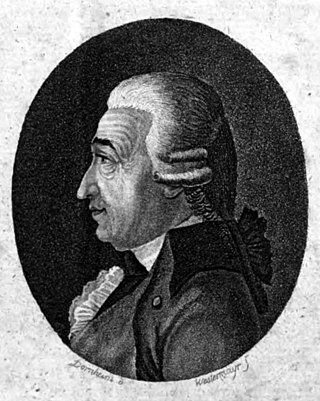
Johann Christian Kittel was a German organist, composer, and teacher. He was one of the last students of Johann Sebastian Bach. His students included Michael Gotthard Fischer, Karl Gottlieb Umbreit, Johann Wilhelm Hässler and Christian Heinrich Rinck. See: List of music students by teacher: K to M#Johann Christian Kittel.

Classical Weimar is a UNESCO World Heritage Site consisting of 11 sites located in and around the city of Weimar, Germany. The site was inscribed on 2 December 1998. The properties all bear testimony to the influence of Weimar as a cultural centre of the Enlightenment during the eighteenth and early nineteenth centuries. A number of notable writers and philosophers lived in Weimar between 1772 and 1805, including Johann Wolfgang von Goethe, Johann Gottfried Herder, Friedrich Schiller, and Christoph Martin Wieland. These figures ushered in and participated in the Weimar Classicism movement, and the architecture of the sites across the city reflects the rapid cultural development of the Classical Weimar era.

The Seyler Theatre Company, also known as the Seyler Company, was a theatrical company founded in 1769 by Abel Seyler, a Hamburg businessman originally from Switzerland who became "the leading patron of German theatre" in his lifetime. It was largely a continuation of the Hamburgische Entreprise, whose dramaturge was Gotthold Ephraim Lessing and whose main owner was Seyler. The Seyler theatrical company became one of the most famous theatrical companies of Europe in the 18th century, attracting some of Germany's leading actors, playwrights and composers. It originally comprised around 60 members, including an orchestra, a ballet, house dramatists and set designers. Between 1777 and 1778 Seyler employed some 230 actors, singers and musicians. The company was originally contracted by the Hanoverian court with performing at Hanover and other cities of the kingdom. The company would eventually perform all across Germany, and performed for three years at the Weimar Schlosstheater, invited by Duchess Anna Amalia of Brunswick-Wolfenbüttel. When Anna Amalia succeeded in engaging the Seyler Company, this was "an extremely fortunate coup. The Seyler Company was the best theatre company in Germany at that time." The company had an important role in the development of German opera in the late 18th century.

Alceste is an opera in German in five acts by Anton Schweitzer with a libretto by Christoph Martin Wieland. It was commissioned by Abel Seyler for the Seylersche Schauspiel-Gesellschaft, and premiered on 28 May 1773 at the Hoftheater Weimar. Considered a milestone of German opera, it was revived in Weimar and recorded in 1999.

The church of St Peter and Paul in Weimar, Germany, is also known as Herderkirche after Johann Gottfried Herder. It is the most important church building of the town, and is called Stadtkirche, opposed to the courtly Schloßkirche. It has been the church of a Lutheran parish since 1525, after the Reformation. The church is part of the World Heritage Site Classical Weimar, together with other sites affiliated with the Weimar Classicism movement. Inscribed on the World Heritage List in 1998, these sites bear testimony to the cultural importance of Weimar during the late 18th and 19th centuries and the outstanding architecture that arose in response to the cultural values of the time.

Schloss Weimar is a Schloss (palace) in Weimar, Thuringia, Germany. It is now called Stadtschloss to distinguish it from other palaces in and around Weimar. It was the residence of the dukes of Saxe-Weimar and Eisenach, and has also been called Residenzschloss. Names in English include Palace at Weimar, Grand Ducal Palace, City Palace and City Castle. The building is located at the north end of the town's park along the Ilm river, Park an der Ilm. It forms part of the World Heritage Site "Classical Weimar", along with other sites associated with Weimar's importance as a cultural hub during the late 18th and 19th centuries.
Simone Schneider is a German operatic soprano. As a member of Staatstheater am Gärtnerplatz, she performed coloratura roles such as the Mozart's Queen of the Night. As a member of the Staatsoper Stuttgart from 2006, she has performed a wide range of leading roles including Donizetti's Maria Stuarda and the Feldmarschallin in Der Rosenkavalier by Richard Strauss. She performed as a guest in major opera houses in Germany and Europe.

The Weimar courtyard of the muses is a term, that had emerged during the 19th century. It refers to an elite fellowship of people in Classical Weimar (1772-1805), that was made up of nobles and commoners, courtiers, civil servants, writers, artists and scientists, who congregated around the central character, Duchess Anna Amalia of Saxe-Weimar-Eisenach, pioneer of Weimar Classicism and patroness of the arts. Duchess Anna Amalia was the mother and from 1758 until 1775 regent for the infant Grand Duke Karl August von Sachsen-Weimar-Eisenach. Among the poets living in Weimar were the most famous German authors of their time, Johann Wolfgang von Goethe, Friedrich Schiller, Christoph Martin Wieland and Johann Gottfried Herder.
Christian Johann Christoph Schreiber was a German theologian, philologist, philosopher, and poet. He was also the Superintendent of the dioceses of Lengsfeld and Dermbach. He was connected in friendship or correspondence to writers and philosophers of his time, and published poetry, sermons, historical and philosophical works.
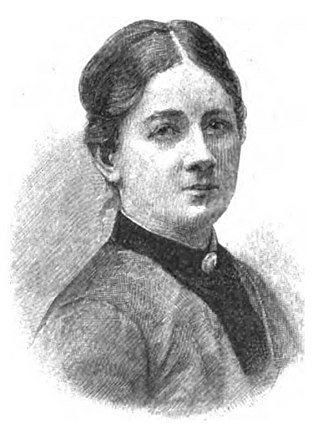
Natalie von Milde, Natalie Haller until 1881 was a German writer and feminist. She was an adoptive daughter of Rosa von Milde (1827–1906) and Hans Feodor von Milde (1821–1899).

Michael Knoche is a German librarian and promotor of the social role of libraries. He has received the Order of Merit of the Federal Republic of Germany, the Gutenberg Prize of the City of Mainz, and he is a member of the International Gutenberg Society. In 2004, Knoche rescued the Luther Bible when the Herzogin Anna Amalia Library caught on fire.
